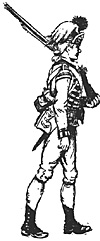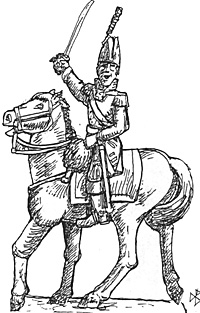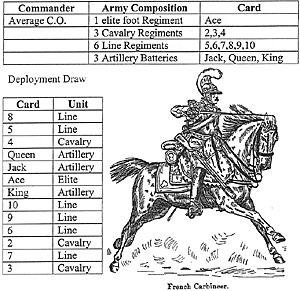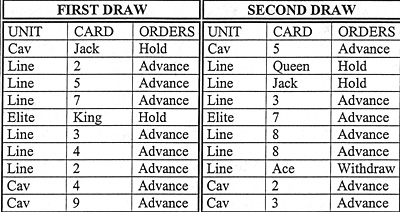 Most solo wargamers are searching for a system to control the enemy army and most end up with complex, if workable systems, based on dice, cards, common sense and wargaming experience. This is a system based solely on the use of a deck of playing cards. It is essentially simple and variety can be added when you see fit. I have, in one or two instances, shown how this can be done.
Most solo wargamers are searching for a system to control the enemy army and most end up with complex, if workable systems, based on dice, cards, common sense and wargaming experience. This is a system based solely on the use of a deck of playing cards. It is essentially simple and variety can be added when you see fit. I have, in one or two instances, shown how this can be done.
Deployment
The first requirement is to determine the line-up of the "automatic enemy". Start by deciding whether the Army C.O. is poor, average or good, and then what units are to be used and of what quality, e.g. elite, line, light, cavalry, artillery, etc. Next, from the deck of cards find the following for each unit:
- 1) Elite an ace
2) Line, Light Cavalry a number card
3) Artillery a picture card
Shuffle these cards well, drawing each in turn, lay out the unit on the table; move from left to right.
Now - a poor C.O. can alter the position of one of these units - you may place it where you like. An average C.O. can alter two units; a good C.O. can alter three. Moving the units can iron out silly situations that may arise (cavalry in woods; heavy infantry in a marsh!)
However, basically this system means that a poor C.O. will make poorer dispositions than a good one.
Army Orders
 Sort out a red suit and shuffle it well. Then draw one card.
Sort out a red suit and shuffle it well. Then draw one card.
- CARD ORDER
Ace Army commences to withdraw
Number Army is to advance
Picture Army hold its position
If the army withdraws, it draws no unit order cards and no C.O. can halt it.
If the army is to advance, then it does so for two moves before drawing unit order cards. An average C.O. may hold 10% of his unit back if he wishes. A good C.O. may hold 50% of his unit if he wishes.
If the army is to hold, then it draws no unit order cards. When opposition is close then a good C.O. can skirmish or make local attacks with odd units. A poor or average C.O. must hold until contact.
Unit Orders
Put all the cards together and shuffle well. Then, moving left to right, draw one card for each unit.
- CARD ACTION
Ace Withdraw one move
Number card Advance
Picture card Hold
Only artillery is not subject to this rule, as this is a supporting rather than an attacking arm and most C.O.'s attach artillery to support a particular unit or attack as necessary, and so should be under direct control. Each move - put the used cards back into the pack and shuffle for the next move.
You can, of course, vary an army's character by the number of cards. A Napoleonic Spanish army might have more aces and picture cards than number cards. An Ancient British army might have one picture card and the rest aces and number cards - so you can at least reflect your favourite army's national characteristics.
 Example
Example
To make the foregoing clear I have prepared an example:
- Commander: Average CO
- Army Composition Card
1 elite foot Regiment Ace
3 Cavalry Regiments 2,3,4
6 Line Regiments 5,6,7,8,9,10
3 Artillery Batteries Jack, Queen, King
Deployment Draw
- Card Unit
8 Line
5 Line
4 Cavalry
Queen Artillery
Jack Artillery
Ace Elite
King Artillery
10 Line
9 Line
6 Line
2 Cavalry
7 Line
3 Cavalry
Army Order Draw
The Army draws a "four" so the general plan is to advance on the enemy. Being an average C.O. he may advance for two moves with 10% held back as a reserve if he wishes.
 Unit Order Draws
Unit Order Draws
After two moves the first and second draws look like this.
And so on until the end of the game.
A Little Common Sense
When using all of the foregoing rules, some irrationalities will arise. Try resolving these within the spirit of the game. Also, your decisions should reflect the calibre of the C.O. - poor, average or good. Also, once fighting has begun and units start to go into "uncontrollable advances" or are rallying after losing a melee or crumble and run off, a unit order card need not be drawn. Similarly, a poor C.O. might press with fresh units when losing or withdraw when winning! And so bear this in mind also when cards seem to produce a surprising manoeuvre!
Finally please feel free to tinker with or amend any or all of the foregoing suggestions. I would be the last to say it was perfect - so the refinements are there for you to make yourself.
Back to Table of Contents -- Lone Warrior # 145
Back to Lone Warrior List of Issues
Back to MagWeb Magazine List
© Copyright 2004 by Solo Wargamers Association.
This article appears in MagWeb (Magazine Web) on the Internet World Wide Web.
Other articles from military history and related magazines are available at http://www.magweb.com
